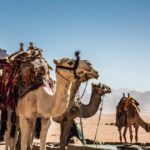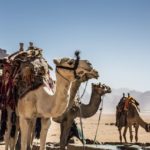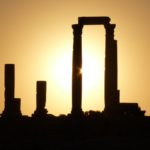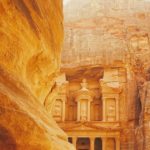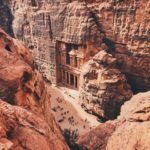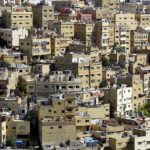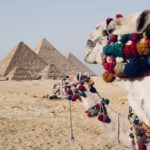A Day with a Bedouin Guide in Wadi Rum, Jordan
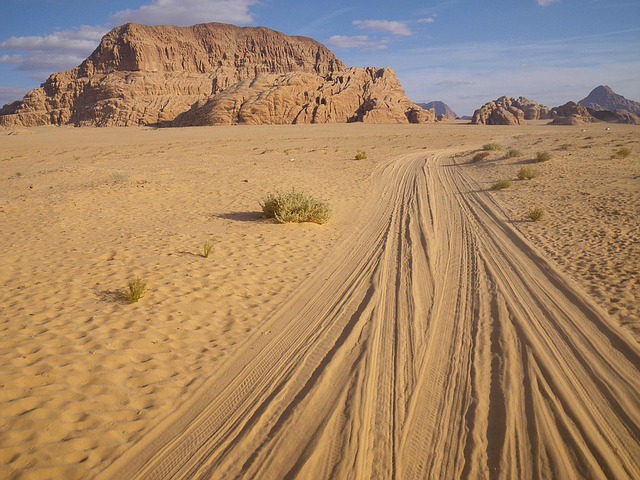
I have an unquenchable thirst to experience how others live in different cultures. This led me on a two-day solo trip to Jordan after a church pilgrimage to the Holy Land. I had booked a second day in Wadi Rum after being inspired by the movie Lawrence of Arabia. Lawrence is a legend, but I was especially intrigued by the territory, the magnificent desert scenery and the Bedouin way of life.
My taxi driver, Mahmood, picked me up at the Wadi Musa Hotel. We climbed higher and higher along a superb black-topped Jordanian highway parallel to the Dead Sea, west of the mountains. We had not seen another vehicle on the road for 20 minutes before we noticed a Bedouin man in his flowing white robes and his red-checked keffiyeh standing beside a Toyota truck. Red and yellow sand stretched in all directions, with granite mountains in the background. We had reached Wadi Rum, and he was to be my guide for the day.
Mohammed drove us through desert valleys, past mountainous rocks, some of which rose almost vertically from the desert floor, which was about 900 metres above sea level. I could see why this area attracted rock climbers, but we saw no sign of humans during our first hour, only a herd of wild camels. The highest peak, at 1754 metres, was Jebel Rum, overlooking Rum Village. There are others close to this height, some granite, some sandstone, of different colors.
Nearly 20 years ago, the Jordanian Government made it compulsory for children to attend elementary school. They offered to provide basic concrete-block homes with running water, electricity and basic sanitation for Bedouins who had always been nomadic. Some of the 5000 living in the Wadi Rum accepted the offer, and now lived in villages. They send their children to schools in Rum village, where there was also a visitor center.
While lifestyles, language, religious practices and beliefs may be very different, our humanity is very similar, as I discovered in the Wadi Rum.
For centuries, different Bedouin tribes have pitched their tents in the shade of some of these gigantic rocks. There are now over 25,000 petroglyphs, dating to several thousand years B.C.E., which have been designated a UNESCO World Heritage Site. There are also 20,000 inscriptions, mostly carved into the rocks by Nabateans and Themudic people in the 4th century C.E.
At one point, my guide stopped and wanted me to climb up to see some petroglyphs. Usually, I would have been enthusiastic, but I was nursing a sprained ankle that I had abused by walking 9 kilometres on it the previous day in Petra, so I declined his invitation. He kindly took one of my cameras and climbed up to take photos of them for me.
While we drove around parts of the 720 square kilometre desert, we talked about Jordan, its economy and government, life for the Bedouin, education, healthcare, and many other topics, making some comparisons with America, about which Mohammed was well informed. His English was good. He had been a tour guide for years. He also owned some goats. Two of his sons tended them in the day, and they were safely corralled at night next to his concrete block house. His village was built in an oasis, so it had a few date palms and olive trees. He talked about his 10 children, the oldest of whom, at 19, had married an American girl who had visited Wadi Rum with her senior class.
After driving around for a couple of hours, Mohammed took me to his home for lunch. It was Ramadan so all his family over the age of 12 were fasting. His two youngest children, aged five and eight, joined me in eating the tasty couscous-vegetable dish he prepared. I was surprised by how connected the people in this remote area were because they all had cell phones. We had seen a tall cell phone tower in the middle of the desert when we were driving, but once in his home I understood how Mohammed was so informed about the world. He had a huge TV and an amazing array of DVDs, recorders and speakers and a small satellite dish on the roof.
His eight-year-old son seemed very familiar with the operation of all this equipment. The rest of the room was carpeted, with low cushioned benches around the walls, on which the family slept. I believe they took their meals sitting on the floor in the center. I ate from a plate on my lap while sitting in one of the armchairs, along with his youngest daughter. She was exceptionally beautiful, with huge brown eyes and a contagious smile. She wanted to hold my hand and sit close to me. Her brother was more outgoing, and when he had finished showing off the TV (which seemed to get all the British and American channels), he wanted to show me how I should be wearing the white hijab I had bought in Petra the day before to protect me from the sun, since I hadn’t brought a hat.
After we had eaten, I asked Mohammed if I could take photos of his children and the house, and he consented. He had taken his thoabs (robes) off once inside the house, and was clad in what I would have called underwear! His American daughter-in-law came in, wearing a black abaya, though her face was not covered. We talked for a while. She seemed very content with her life with the family, helping her mother-in-law with chores and working part-time at the visitor center in Rum.
I thoroughly enjoyed my day immersed in the Bedouin culture of Wadi Rum. I discovered that while lifestyles, language, religious practices and beliefs may be very different, our humanity is very similar. We have much to learn from each other if we take opportunities to get to know those who appear different from us.

